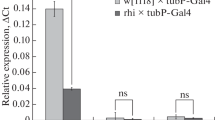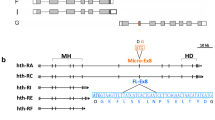Abstract.
RT-PCR was applied to analyze the splicing patterns of P-element-derived mRNAs in Drosophila bifasciata, D. helvetica, and Scaptomyza pallida. D. melanogaster was used as a control. The experiments revealed that P elements are transcribed in all species investigated. However, there are differences in the splicing patterns of IVS3, which has to be removed in order to produce transposase mRNA instead of repressor mRNA. These differences are observed among species as well as between the P element subfamilies, the M and the O type, which coexist in the genomes of D. bifasciata and S. pallida. In D. helvetica M-type transposase mRNA was found in the germline and repressor mRNA in the soma, as has been previously described for the canonical (M-type-related) P element of D. melanogaster. In contrast, in S. pallida only repressor mRNA of M-type elements was detected in all tissues. In D. bifasciata, M-type IVS3, although activated both in the soma and the germline, is never completely excised. Instead, two alternative double-spliced variants occur in which two small introns are removed within the IVS3 region. One of these variants codes for a protein 12 aa longer than the regular transposase. Taking these findings together, transposase production and transpositional activity of M-type elements seem to be limited to D. helvetica and D. melanogaster, whereas M-type elements have become immobile in D. bifasciata and S. pallida. Unlike the M type, the splicing of O-type transcripts in D. bifasciata and S. pallida follows the classical rules of tissue-specific P element regulation: transposase mRNA is produced exclusively in the germline whereas repressor mRNA is formed in somatic cells. Thus O-type elements are thought to be still transpositionally active in both species. This finding is in accordance with the postulated recent transfer of O-type elements between the gene pools of D. bifasciata and S. pallida. In addition, we were able to show that the IVS3 double-spliced variants of both P element types are produced regularily in all species of the genus Drosophila investigated so far, but not in S. pallida.
Similar content being viewed by others
Author information
Authors and Affiliations
Additional information
Received: 13 May 1997 / Accepted: 9 October 1997
Rights and permissions
About this article
Cite this article
Haring, E., Hagemann, S. & Pinsker, W. Transcription and Splicing Patterns of M- and O-Type P Elements in Drosophila bifasciata, D. helvetica, and Scaptomyza pallida . J Mol Evol 46, 542–551 (1998). https://doi.org/10.1007/PL00006335
Issue Date:
DOI: https://doi.org/10.1007/PL00006335




